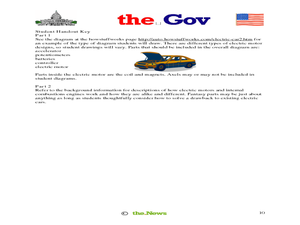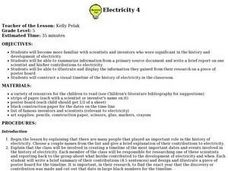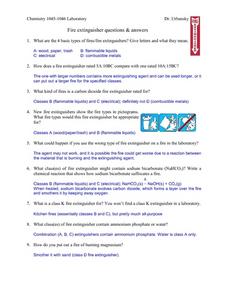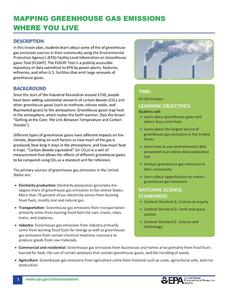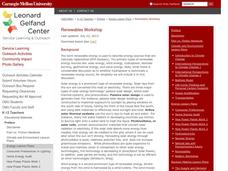Curated OER
Lemon Battery
Students construct their own battery made of lemons. In this electrochemistry lesson, students explain why lemons conduct electricity. They perform a series of experiments to investigate its conductivity.
Curated OER
All About Circuits ~ Atomic Structure
In this interactive Internet assignment, physical science investigators answer 11 questions about the atom, the subatomic particles, and atomic structure. They can click on "Reveal Answer" to discover if they are correct. They also...
Kenan Fellows
Ready, Set, Save on Solar Energy Technology!
Does your class have a bright future in the solar energy industry? Science scholars take an in-depth look at what's new in solar technology. After completing research into the solar industry, participants create and market a product in...
Wind Wise Education
Understanding Forms and Sources of Energy
What is the difference between a form of energy and a source of energy? This first activity in a series of 19 lessons uses demonstrations and discussions to introduce energy to the class. Through using hand-generator flashlights,...
Institute of Electrical and Electronics Engineers
The Power of Graphene
To prepare for the activity, STEM classes read about nanotechnology and the amazing properties of graphene. They collect a graphene sample from pencils, and then connect them into simple circuits to determine whether it makes a better...
Curated OER
Electric Car: American Industry and Innovation
Students study how an electric car operates. In this electric car instructional activity students assemble an electric car motor from parts from an internal combustion engine.
Curated OER
Magnetism
Attract your class to magnetism with this straightforward presentation. Using bullet points and simple phrases, viewers are taught the basics of magnetism. There are no pictures or diagrams to help explain, so you might want to add a few...
Curated OER
Electricity 4
Fifth graders create a timeline of the most important dates and events involved in the history of electricity. Each student researches one scientist and designs and illustrates a piece of a poster board for the timeline.
Urbana School District
Light
You matter, unless you multiply yourself by the speed of light ... then you energy. Presentation covers the behavior of light as both a wave and a particle, light versus sound, space travel, why objects have colors, depth perception,...
Curated OER
Chemistry of Fire
In this science worksheet, students are involved in questions about the events that cause and sustain fires. The chemistry of fire is the primary focus.
Clean Up Australia
Why are Batteries Harmful to the Environment?
Open this lesson by reading together about primary and secondary batteries (such as nickel-cadmium cells), problems they can cause in the environment, and how humans can minimize the damage. Afterward, little ones examine a collection of...
Curated OER
Circuits and Conductors
Fourth graders investigate the concepts of circuits and conductors. In this circuits and conductors lesson set, 4th graders watch demonstrations of circuits and look at images to identify whether they are complete circuits. They test...
Curated OER
Incandescent Light Bulb
Learners study the history of the light bulb and how an incandescent light bulb works. In this electricity instructional activity students complete several experiments on the light bulb.
US Environmental Protection Agency
Mapping Greenhouse Gas Emissions Where You Live
After investigating the US Environmental Protection Agency's climate change website, your environmental studies learners discuss greenhouse gas emissions. They use an online interactive tool to look at data from power production...
Carnegie Mellon University
Renewables Workshop
Youngsters examine resource maps to find out which states are using solar and wind power and discuss as a class various other renewable energy sources. They use a provided data table to record pros and cons to each technology, build and...
Curated OER
Help Wanted: A Lighting Engineer For Popular Rock Group
Students are assigned to groups, and determine each member's role in the group. They will design an experiment to determine a way to produce the three primary and five secondary colors. Students discuss color and mood. They listen to a...
Curated OER
Electrical Battery
Students investigate the different types of batteries and how they work. In this energy lesson students experiment with batteries and see which ones last the longest.
Curated OER
Physics Quiz
In this physics worksheet, students complete short answer questions about physics concepts such as electricity, space, light, and more. Students complete 20 short answer questions.
Curated OER
Primary Resources
In this teacher website, teachers have access to various worksheets and lesson plans at no cost. Teachers can select from all subject areas for lesson plans, activities, and available resources.
Virginia Department of Education
Metals, Nonmetals, and Metalloids
How can one easily classify metals, nonmetals, and metalloids? Pupils answer this question as they experiment with unknown substances and perform tests on conductivity, brittleness, and malleability to determine...
Virginia Department of Education
Mystery Iron Ions
Young chemists perform an experiment to determine if a compound is iron (II) chloride or iron (III) chloride. Then they determine the formula, balance the equation, and answer analysis questions.
Virginia Department of Education
Properties of Compounds and Chemical Formulas
Young chemists have unknown compounds they need to sort. Performing three different tests on each, the chemical behaviors they observe become the basis for data analysis.
American Institute of Physics
African American Inventors in History
A two-part lesson plan introduces young historians to the work of famous African American inventors. Groups first research and develop a presentation of an inventor that includes biographical information and information about one of...
Curated OER
Rechargeable Batteries
Students explore how rechargeable batteries work by conducting a series of experiments. In this physics lesson plan, students discuss the benefits of using rechargeable batteries over disposable ones. They build their own battery charger...







